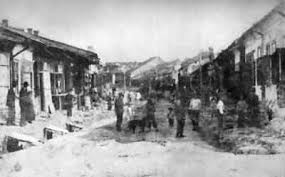Levi Memoir 1860 – 1900 Falticeni, Romania

We are all originating from a little town, Falticeni, Romania.
The earliest written mention of the village Falticeni is from March 1490, and the second from March 1554, when Moldavian Prince Alexandru Lăpuşneanu, awarded the estate and the village bearing the aforesaid name to Moldovița Monastery.
Fălticeni was first mentioned as an urban settlement in August 1780 as Târgul Șoldănești (Șoldănești Market), after the name of a local boyar’s estate, in a document issued by the chancellery of Prince Constantin Moruzi. In March 1826, an edict issued by Prince Ioan Sturdza changed the name of the town to Fălticeni.
The town was very close to trade routes linking the Black Sea with Poland, Germany, and the Baltic basin. Merchants traveling from Central Europe via Poland to Black Sea, would pass through Falticeni and other Romanian villages. Often, the Jewish merchants would visit the local synagogues and inquire about lodging within Jewish community in order to easily conform to their traditions of meals and prayers.
Our story starts around 1860 (give and take about 3 years), when a Spanish merchant, named Levi, passing through, and possibly lodging with one of the Jewish families, fell in love and married Yetl Fenster, a lovely young Jewish girl. At the time he was nicknamed, Levi the Espagnol, since he said he was hailing from Spain. We do not know from what city in Spain, what was he trading in or his first name. However, the name Levi, spelled with an “i” confirms Sephardic origin.
Levi and Yetl had, two children, Moise and Leonora about three years apart. After the birth of the second child, Levi the Espagnol left Falticeni, never to return.
Here the family versions of his disappearance differ.
Version 1: Sophica, (Moise’s daughter) told Adina (Moise’s grand-daughter) that Levi tried to convince Yetl to go back with him and the children to his country, which he missed greatly. Allegedly, Yetl feared the change and preferred to stay behind in her uncle’s house.
Version 2: Maya, Moises’ grand daughter was told that Levi, allegedly left for a business trip. After a while, the family received news, that Levi the Espagnol, was killed while crossing the Alps. However, suspicions abounded and rumors implied that the Espagnol, was not killed, but instead went back to a Spanish wife he never told anybody about. In fact, he might have even had children in Spain. This is and will remain the greatest mystery of our family.
Getting back to poor Yetl, she and her two children, had to go back to her family s house. Yetl, per Clara’s (Ruta) memories was a tiny woman, with green eyes and nice rosy cheeks, even as an older woman.
Fenster family is to his day, tightly connected to all descendants of Levi the Espagnol.

